
|
Astronomy Picture Of the Day (APOD)
 Sand Dunes Thawing on Mars
Sand Dunes Thawing on Mars
24.09.2019
What are these strange shapes on Mars? Defrosting sand dunes. As spring dawned on the Northern Hemisphere of Mars, dunes of sand near the pole, as pictured here in late May by ESA's ExoMars Trace Gas Orbiter, began to thaw.
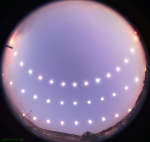 Equinox: The Sun from Solstice to Solstice
Equinox: The Sun from Solstice to Solstice
23.09.2019
Today is an equinox, a date when day and night are equal. Tomorrow, and every day until the next equinox, the night will be longer than the day in Earth's northern hemisphere, and the day will be longer than the night in Earth's southern hemisphere.
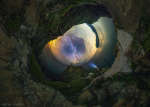 Eye Sky a Dragon
Eye Sky a Dragon
22.09.2019
What do you see when you look into this sky? In the center, in the dark, do you see a night sky filled with stars? Do you see a sunset to the left? Clouds all around? Do you see the central band of our Milky Way Galaxy running down the middle?
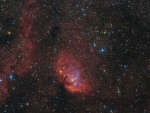 The Tulip in the Swan
The Tulip in the Swan
21.09.2019
Framing a bright emission region, this telescopic view looks out across a pretty field of stars along the plane of our Milky Way Galaxy, toward the nebula rich constellation Cygnus the Swan. Popularly called...
 Saturn at Night
Saturn at Night
20.09.2019
Still bright in planet Earth's night skies, good telescopic views of Saturn and its beautiful rings often make it a star at star parties. But this stunning view of Saturn's rings and night side just isn't possible from telescopes closer to the Sun than the outer planet.
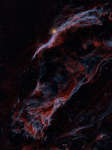 Along the Western Veil
Along the Western Veil
19.09.2019
Delicate in appearance, these filaments of shocked, glowing gas, are draped across planet Earth's sky toward the constellation of Cygnus. They form the western part of the Veil Nebula. The Veil Nebula itself is a large supernova remnant, an expanding cloud born of the death explosion of a massive star.
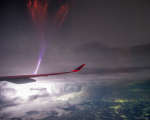 Gigantic Jet Lightning over India
Gigantic Jet Lightning over India
18.09.2019
Yes, but can your lightning bolt do this? While flying from Munich to Singapore earlier this month, an industrious passenger took images of a passing lightning storm and caught something unexpected: gigantic jet lightning. The jet was captured on a single 3.2-second exposure above Bhadrak, India.
 Water Vapor Discovered on Distant Exoplanet
Water Vapor Discovered on Distant Exoplanet
17.09.2019
Where else might life exist? One of humanity's great outstanding questions, locating planets where extrasolar life might survive took a step forward recently with the discovery of a significant amount of water vapor in the atmosphere of distant exoplanet K2-18b.
 A Lunar Corona over Turin
A Lunar Corona over Turin
16.09.2019
What are those colorful rings around the Moon? A corona. Rings like this will sometimes appear when the Moon is seen through thin clouds. The effect is created by the quantum mechanical diffraction of light around individual, similarly-sized water droplets in an intervening but mostly-transparent cloud.
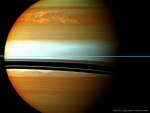 A Long Storm System on Saturn
A Long Storm System on Saturn
15.09.2019
It was one of the largest and longest lived storms ever recorded in our Solar System. First seen in late 2010, the above cloud formation in the northern hemisphere of Saturn started larger than the Earth and soon spread completely around the planet.
|
January February March April May June July August September October November December |
|||||||||||||||||||||||||||||||||||||||||||||||||